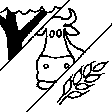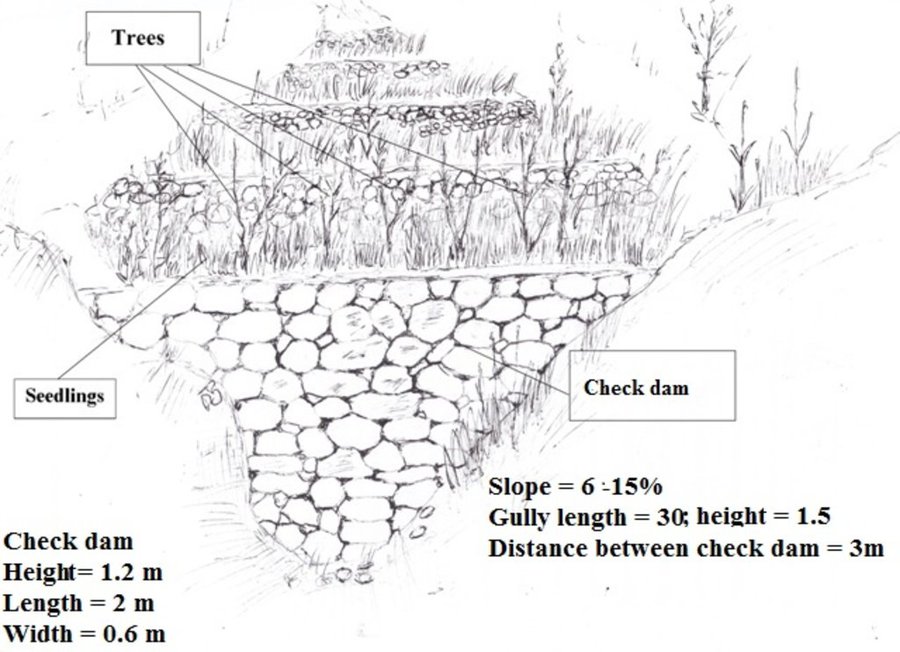



Project supported implementation of gully treatment has taken place in the villages Sari Joy and Jawaz Khana, located in Chokar watershed of Rustaq District in Northern Afghanistan. The Chokar watershed is a mountainous area situated between 600 m and 2,500 m above sea level. The climate is semi-arid with harsh and cold weather in winter and hot and dry summers. The annual precipitation in average years is 580 mm. Land degradation affects all forms of land use and includes sparse vegetation cover, severe topsoil erosion from water, and poor soil fertility. Unsustainable agricultural practices, together with over-exploitation and high pressure on the natural resources, are adversely impacting the socio-economic well-being of local communities, as well as contributing to the risk of being adversely affected by drought, and also leading to landslides and flash foods triggered by heavy rainfall. The data used for the documentation of the technology are based on field research conducted in Chokar watershed, namely in the villages of Sari Joy and Jawaz Khana. These villages represent the upper and the middle zone of Chokar watershed, respectively. They differ considerably in access to services and infrastructure, but in general are poorly served. The communities depend on land resources for sustaining their livelihoods. In a good year with high yields, wheat self-sufficiency lasts about 5 months. The villages are home to ethnic Qarluq communities. Since 2012 the Livelihood Improvement Project Takhar (LIPT) implemented by Terre des hommes (Tdh) Switzerland has initiated a range of NRM interventions.
The Livelihood Improvement Project in Takhar supported Natural Resources Management Committees to rehabilitate two gullies with check dams and trees in Sari Joy and Jawaz Khana. The check dams are made of stone walls built across the widest section of the gully. Jute bags filled with soil are used in the narrower sections of the gully to form a solid barrier for soil to accumulate. Tree seedlings and cuttings of Russian willow and acacia are planted between the check dams to stabilize the soil. During the first 2-3 years, the trees need to be protected from grazing, and from cutting for fuelwood. Watering of the trees may also be required during the dry season, especially in Jawaz Khana, to support their survival. Such methods of gully rehabilitation are feasible in the area, since the construction and planting materials are locally available. However, the costs for establishing the check dams remain relatively high and the local villages have contributed mainly with labour inputs, while the costs for construction material were provided by the project.
Check dams inside the gully slow the water flow and help its infiltration into the soil. The structures also collect sediment and reduce further erosion of the gully bed, and prevent its expansion in the area. Well managed check dams, after several years, can produce trees for fuelwood and grass for animal fodder.
Rehabilitation of gullies is an innovative practice for the local land users, but it is supported by the local communities for its visible impact on preventing further erosion and loss of community land used for crop cultivation, forest and orchards. After taking part in the design and implementation of rehabilitation activities, the local land users expressed that they had acquired useful skills and will be able to conduct these works independently if the material resources are available.
Women support the work by preparing and bringing food to the workers in the field. Women are also occasionally involved in filling the jute bags with soil and bring the bags to the gully. This requires significant inputs, bearing in mind that gullies are often formed in very steep areas where there are no roads - and thus the food and other material can be delivered only by foot or with a donkey.

ទីតាំង: Sari Joy and Jawaz Khana Villages, Takhar Province, Rustaq District, ប្រទេសអាហ្វហ្គានិស្ថាន
ចំនួនទីកន្លែងបច្ចេកទេស ដែលវិភាគ: 2-10 កន្លែង
ការសាយភាយនៃបច្ចេកទេស: អនុវត្តនៅកន្លែងជាក់លាក់មួយ/ ប្រមូលផ្តុំនៅតំបន់តូចៗ
កាលបរិច្ឆេទនៃការអនុវត្ត: តិចជាង 10ឆ្នាំមុន (ថ្មី)
ប្រភេទនៃការណែនាំឱ្យអនុវត្តន៍៖






| បញ្ជាក់ពីធាតុចូល | ឯកតា | បរិមាណ | ថ្លៃដើមក្នុងមួយឯកតា (ដុល្លារអាមេរិក) | ថ្លៃធាតុចូលសរុប (ដុល្លារអាមេរិក) | % នៃថ្លៃដើមដែលចំណាយដោយអ្នកប្រើប្រាស់ដី |
| កម្លាំងពលកម្ម | |||||
| Design of the check dam | person-day | 2,0 | 5,3 | 10,6 | |
| Digging the gully for preparation of construction work | person-day | 8,0 | 5,3 | 42,4 | |
| Construction of stone wall | person-day | 12,0 | 5,3 | 63,6 | |
| Planting of tree seedlings and cuttings | person-day | 2,0 | 5,3 | 10,6 | 100,0 |
| សម្ភារៈ | |||||
| Meter | piece | 1,0 | 2,2 | 2,2 | |
| Shovel | piece | 2,0 | 3,8 | 7,6 | |
| Axe | piece | 1,0 | 2,2 | 2,2 | |
| Wheelbarrow | piece | 1,0 | 38,0 | 38,0 | |
| Rope | meter | 100,0 | 0,07 | 7,0 | |
| Pick axe | piece | 1,0 | 3,0 | 3,0 | |
| Hammer | piece | 1,0 | 2,2 | 2,2 | |
| សម្ភារៈដាំដុះ | |||||
| Cuttings | piece | 100,0 | 0,37 | 37,0 | 50,0 |
| Seedlings | piece | 10,0 | 0,6 | 6,0 | 50,0 |
| សម្ភារៈសាងសង់ | |||||
| Stone | cubic meter | 6,0 | 7,49 | 44,94 | |
| ថ្លៃដើមសរុបក្នុងការបង្កើតបច្ចេកទេស | 277.34 | ||||
| បញ្ជាក់ពីធាតុចូល | ឯកតា | បរិមាណ | ថ្លៃដើមក្នុងមួយឯកតា (ដុល្លារអាមេរិក) | ថ្លៃធាតុចូលសរុប (ដុល្លារអាមេរិក) | % នៃថ្លៃដើមដែលចំណាយដោយអ្នកប្រើប្រាស់ដី |
| កម្លាំងពលកម្ម | |||||
| Protecting the trees from animals | person day | 45,0 | 1,3 | 58,5 | 100,0 |
| Watering the trees | person day | 10,0 | 5,3 | 53,0 | 100,0 |
| ថ្លៃដើមសរុបសម្រាប់ការថែទាំដំណាំតាមបច្ចេកទេស | 111.5 | ||||
Treatment of gullies on cropland, forest (mixed) land and grazing land protects the land from further erosion and protects the crop.
Through implementation of gully treatment the area that was lost to gully formation can be used for production purposes again.